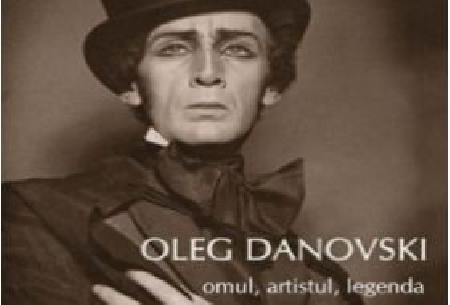“Oleg Danovski – the Man, the Artist, the Legend”
The Romanian Cultural Institute in Bucharest last month played host to the launch of one of the few books on Romanian dance: “Oleg Danovski – the Man, the Artist, the Legend, written by Doina Jela. The book is a biography of the man whose creative genius

Eugen Cojocariu, 29.04.2012, 17:31
The Romanian Cultural Institute in Bucharest last month played host to the launch of one of the few books on Romanian dance: “Oleg Danovski — the Man, the Artist, the Legend”, written by Doina Jela. The book is a biography of the man whose creative genius inspired and fed into the ballet of the Romanian Opera in the 1941-1977 period, a time span of nearly 40 years. Danovski also founded the first ballet theatre in Romania, as well as one of the top-performing ballet groups in Europe, both in the eastern city of Constanta.
Oleg Danovski was born on February 9th 1917 in the city of Voznesenk, in Trava guberniya, Ukraine. As author Doina Jela points out, his mother took him to Romania in his early years. At age 17 he became a “stage legend”, as Doina Jela describes him, or the “Slavonic prince” and later “the Slavonic sphinx”.
At merely 18 years of age he was employed as a choreographer at Carabus Theater, only to become the youngest choreographer of his time, to the pride of actor and pamphleteer Constantin Tanase, then director of the theatre. Danovski signed dozens of original choreographies, which were “stunning in terms of technical accuracy, stage direction, creativity as well as something that always brought abstract ideas to mind and was telling of deeper, metaphysical meanings.
People used to describe him as follows: “Oleg? Well, Oleg is something else”, writes the author in the Preface. She adds: “20 years since he passed away, Oleg Danovski’s personality remains shrouded in legend. One cannot live without legends. This book is an attempt to go beyond the legend in order to unveil the portrait of a man and tell his story”.
Doina Jela is a novelist, editor and author of a large number of essays, reviews, interviews. At present she works as an editor and series editor at Curtea Veche Publishing, which brought out Danovski’s biography in cooperation with the “Camil Petrescu” Cultural Foundation. Doina Jela sums up the process of writing this book:
Doina Jela: “The story of writing this book started back in 1980 or 1981, when I was a teacher in a village in Constanta County near Medgidia. I saw a poster announcing the tour of ‘The Miraculous Mandarin’ by Oleg Danovski at the local Cultural Centre. I had already seen some other shows with artists coming from Bucharest or some other big cities. I was accustomed to seeing artists go on tours out of Bucharest to relax, and not to electrify performance halls, probably because they did not believe in the value of small town audiences. ‘The Dangerous Mandarin’ by Oleg Danovski is, as I wrote in my book, a ‘grand opera’ show. The show, as I saw it in Medgidia, was breathtaking, and I was amazed not so much to find that such a performance is possible, but rather to see that the artists put on a show as if they were performing before a knowledgeable jury. Everything was perfect, it was breathtaking. That was my first meeting with Oleg Danovski. I knew that he was working in Constanta and I was wondering how he could manage to overcome the daily routine, rust and ruin — the three inconveniences of living in the province.“
Back in 1993-1994, two years before the artist‘s death, that came in 1996, Doina Jela recorded almost 20 hours of interviews with Oleg Danovski for the Tomis magazine, which she included in her book
Doina Jela: “He was a genius, he was a high-flier. Whatever he did was definitely above what he had known. And in addition, he was a very charismatic person. If you read the interviews, you will find that everything he says is brilliant and far-reaching.“
Here is a sample of Oleg Danovski‘s statements included in Doina Jela‘s book: Quote “I live for one thing alone, and that is ballet. If you ask me what the use of theatre or culture in general is, I will answer by quoting one of my friends saying, ‘A country without culture is a barbarous country. My aim is to help put an end to barbarity.“
Dance critic Gina Serbanescu recommends Oleg Danovski‘s biography to all those who want to understand how a model is shaped and she describes the book “Oleg Danovski – The Man, the Artist, the Legend” as follows:
Gina Serbanescu: “Mrs. Doina Jela has the merit of having put three hypostases into an equation, and you can not leave any of the variables aside of the equation. Because you cannot isolate the man from the artist and the artist from the legend, and all of them are intertwined. Through this highly important cultural document, Doina Jela sheds light on a less known facet of Oleg Danovski‘s personality, providing an insight into the human dimension of genius.“
We have also asked the author, Doina Jela, about her feelings when the volume came out:
Doina Jela: “I think Oleg Danovski deserves this book, and I pray that God will help people receive that as I meant it to be received. I wouldn’t like to see a clash of egos, with artists counting how many times their names were mentioned in the book. Instead, I would love them to understand my effort and good faith, and my admiration for this great artist.”
The volume “Oleg Danovski — The Man, The Artist, The Legend” came out after six years of thorough documentation, because although dancer, choreographer and director Oleg Danovski died in 1996, there are few documents on his life and work.





























